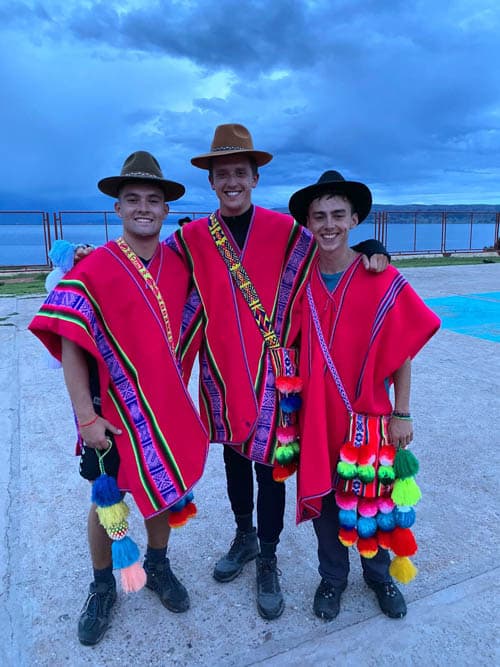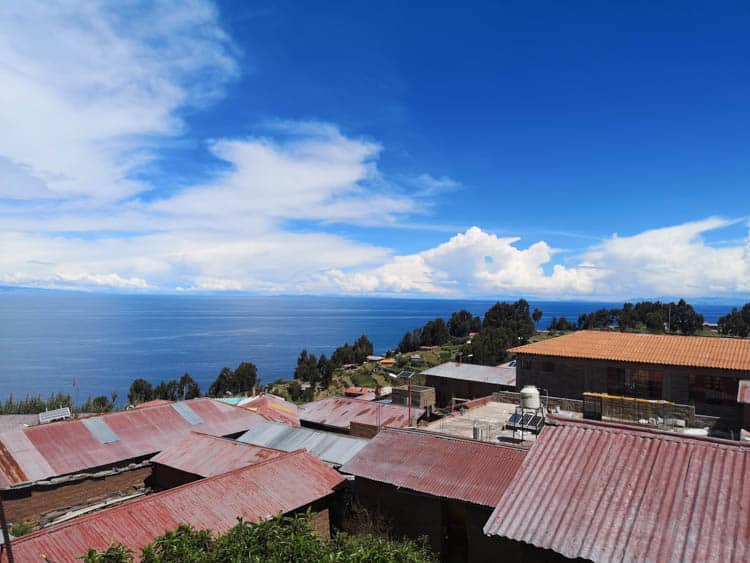
Go World Travel is reader-supported and may earn a commission from purchases made through links in this piece.
Straddling the border between Peru and Bolivia is the world’s highest navigable body of water: Lake Titicaca. As one of the most famous lakes in the world, I was aware of it before my trip.
However, my expectations were absolutely blown out of the water (excuse the pun) with a visit to the manmade Uros floating islands.

Puno to Lake Titicaca
My day started in the city of Puno situated at the edge of the lake on the Peruvian side of the border. I had spent the previous day travelling there on a long bus journey from Cusco.
The only plan that I had when I got to Puno was to take a boat out onto the lake to see the Uros floating islands. After that, I would be staying the night with a host family in a remote village on one of the many peninsulas jutting into the lake.
It was an early start. I immediately should have known that this was going to be anything but a boring 24 hours. I left the hotel with a group of fellow backpackers. We hopped into peddle powered tuk-tuks that took us down to the harbour. This was no simple ride.

The driver of my tuk-tuk looked as though he was in his seventies. But, I had barely sat down before we shot off down the hill and through the streets of Puno. It seemed as though the drivers must have bet on who could reach the harbour first.
They cycled past one another, weaving in and out of the stationary cars. Paying no attention to the colour of any traffic lights that we shot through. I felt as though I was in the Wacky Races.
I made it to the harbour alive. We then boarded the boat that was going to take us around the lake. As I got on the boat I noticed that the only member of the crew was a boy no older than 6.
He was sitting in the driver’s seat. I had learned that things were done a bit differently in Peru, but this seemed to be a bit extreme.
Fortunately, it seemed it was just “bring your son to work day”. About five minutes later the boy’s father, and boat driver, arrived and we were ready to explore the lake.

The Unique Uros Floating Islands
The first stop was the Uros floating islands. These islands are manmade by the Uru people out of the reeds that grow on the lake. When we arrived, it became clear that these islands not only contained the homes of the Uru people but also a soccer pitch and a café to cater for the dozens of tourists that visit every day.
I was delighted to find that this was one of the many locations in South America that you could get a stamp in your passport. These stamps, whilst technically not allowed in your passport, are something that I am always on the lookout for when I travel.
We went ashore onto one of the islands if you can say ashore when talking about a floating reed island that is. Immediately we were invited into one of the family homes.
It was an incredible mix of traditional and modern. Across the floor were strewn brightly coloured cloths in the traditional Uru style. In contrast, there was a television in the back that was connected to the massive aerial on the edge of the island.
The islands themselves were like nothing I had ever experienced before. As I stepped on the reeds, I could feel them give way slightly. It really was a little disconcerting.
When larger boats passed by the islands you could feel the reed island move a little as they passed over the wake. It seemed that the Uru were used to this as they did not bat an eyelid. Some of the older men even laughed as I jumped up and down on the reeds ensuring that they really were safe.

Island of Taquile
Before long, it was time to leave the Uros floating islands and continue our lake excursion. Back on the boat, we started our long trip to the island of Taquile, 45 km from Puno. As we travelled across the lake, the sun which had originally been firmly behind a thick layer of cloud, began to shine through.
Suddenly the lake looked like the perfect place for a cooling dip. Which was exactly what I did. I climbed on top of the boat and hurled myself off before letting out a small yelp as I entered the water. It was far colder than it looked.
After warming up in the Peruvian sun, we arrived at Taquile island. I was surprised to find that the village was situated at the top of the island, approximately 200m above the level of the lake. This led to a hike up a narrow, winding path to the village. To make matters worse, this was all done at an altitude of around 4000m above sea level.
However, the effort was certainly worth it. In the village, we were taken to a tiny little restaurant that seemed to be run out of the back of somebody’s house. I was able to sit at a table with the most remarkable view across the lake into Bolivia while eating one of the best meals I had in Peru.
The meal started with a portion of Quinoa soup, something that I would urge everyone to try of they haven’t already. But, the best was yet to come. The soup was followed by the most delicious trout I’ve ever tasted.
It was freshly caught by the island locals that morning and you could certainly taste that. All of this was done while I sat in the middle of Lake Titicaca, the highest navigable lake in the world.
After a much easier walk back down the hill, it was time to set off for the location of our overnight stay. I wasn’t sure what to expect. I was told that I would be staying with one of my fellow backpackers in the house of one of the local Aymara people and that I shouldn’t be surprised if they didn’t speak any Spanish let alone English.

An Unfortunate Soccer Match
Upon our arrival, we were immediately taken to the school at the heart of this little community. It quickly became apparent that the local young men were challenging us to a soccer match.
We accepted but soon realised that we were out of our depth. Not only did the locals immediately start putting on their brightly coloured soccer boots as we stood there in our walking shoes, but this whole match was also being played at around 3800m above sea level.
If you’ve never played a soccer match at such an altitude, I can tell you that it’s incredibly difficult. Five minutes in I was out of breath. We managed to hold on until it reached 4-4, at which point it was decided that the next goal would be the winner.
It was about then that I innocently passed the ball back to the goalkeeper, only to realise that the goalkeeper wasn’t stood in the goal. I watched in horror as the ball trickled over the goal line, condemning us to a harrowing 5-4 loss.

Traditional Food, Dance and Farming
What to do after such a terrible defeat? The obvious solution is to dress up in Aymaran clothes and attempt a traditional dance to a band made up of the locals. So that is exactly what we did.
There is a video of me somewhere completely forgetting all the moves I was taught as I twirled around large pom poms. Completely out of time with the music. It was now time to be placed with our families for the night. My family was a young couple named Ricardo and Sandra and their 10-year-old daughter, Edith.
We all ate dinner together around their table. It seemed Sandra had been preparing it while we’d played soccer. The meal was similar to our lunch. A homemade soup followed by fresh fish with some potatoes.
We were woken early the next morning to help out with the breakfast preparation. It was some kind of surprisingly tasty fried bread. Apparently, this was to fuel me for my work on the family’s farm plot that morning.
I was sent out to do some serious weeding. Armed with something resembling a pickaxe, I spent about two hours digging up weeds and overgrown plants from the family lot. It made me feel as though I had earned my bed and lodging there the previous night.
Before I knew it, it was time to return to Puno. My 24 hours on Lake Titicaca had come to an end. From start to end it was an experience that I was neither expecting nor will I ever forget. I mean how many people can say that they scored on their own goal on Lake Titicaca.
Book This Trip to Uros Floating Islands
Ready for a once-in-a-lifetime vacation to Lake Titicaca? Start preparing with accommodations, local restaurant reviews, insider tips on how to get around and more through TripAdvisor and Travelocity. Buy your plane tickets and plan ground transportation with CheapOair.
Make the most of your tropical vacation by booking some fun activities in Lake Titicaca through GetYourGuide. Find expert-led tours, unique adventures and tickets here.
Author’s Bio: Matthew Cogan is a young UK based backpacker who has been to 40 countries across 5 continents.
- Discover Claremont, California Along Historic Route 66 - December 6, 2024
- Three Sites to Soothe the Soul in Kyoto, Japan - December 5, 2024
- 13 Essential Tips For Women Traveling in Morocco - December 4, 2024


I like your trip so much, great blog!